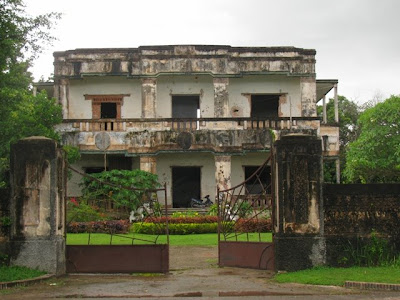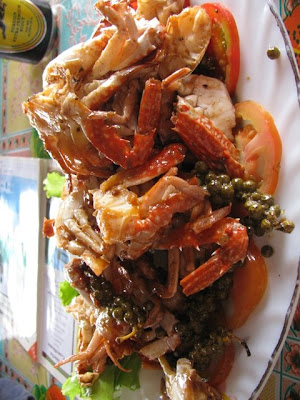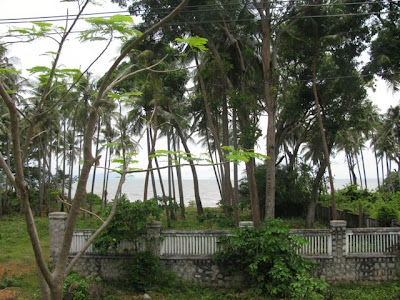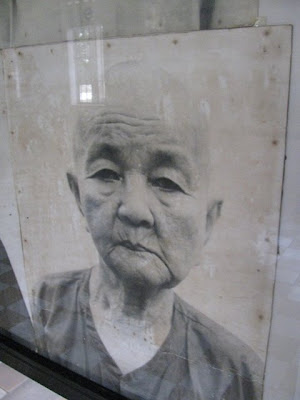Ah, the very words bring up images of mythical sounding New England towns – Hyannisport, Kennebunkport, Bar Harbour - of 1950's stereotypes named Biff and Todd taking their gals to the local Crab Shack to gad about with Kennedy cousins and hand-jiving beach bunnies, getting directions to that night's clambake. I can imagine Archie's gang going to a Crab Shack on a weekend trip to a seaside town where they would be labeled “townies” by the locals, and Gidget - she would eat at a Crab Shack, hell, she'd surf her way right up to the front door and then join Annette Funnicelo and Frankie Avalon for some Beach Blanket Bingo when she was through.
I suppose it is the lack of this kind of beach culture in my own seaside city that has exotified it for me – and why when I heard that the crab capital of South East Asia (and I'd be willing to bet all of Asia) was located in the South of Cambodia in a sleepier than sleepy place called Kep I marked the map and set off.
Located less than 100 km from the frenzied party beaches of Sihanoukville on Cambodia's coast and a stone's throw from the Vietnamese border, Kep is a gloriously laid back town. Formerly a French seaside get-away called Kep Sur Mer, the troubled decades (to put it lightly) since independence have left the grand buildings to decay to mere skeletons, now filled with squatters who care for the vast gardens and string up hammocks in the empty, weather exposed halls. It is Kep's ruined villas and ornately stone walled vacant lots that give the place a deserted, haunted vibe – and an eerie ghosttown beauty.

There is almost nothing to do here – the beach is rocky and brown (the French had white sand trucked in during Kep's heydays) the ocean raging and grey, and everything is connected by meandering country roads and so when you find out that I spent three days here you have to realize that it was for one reason.....
....for Khmer people, the name Kep is synonomous with fresh steaming buckets of crab, and they swarm this unassuming stretch of sand every weekend in search of the stuff. Yes, I'll admit it – we came for the same reason. Good ole' crabby gold.
Our first full day we chartered a fishing boat and headed to nearby Koh Tonsay (Rabbit Island) – a near- deserted island inhabited by a few dozen Khmer catering to daytrippers from Kep. Rubberlegged upon reaching the shore from the bucking waves as we crossed the channel, we trekked for 15 minutes through lush deserted jungle. We emerged on the other side of the island, to an idyllic beach ringed with tree covered hills. A few crab shacks lined the shore, with hammocks out front and bungalows for rent, and so we chose a spot to lay in, went for a swim in the bathtub-warm water and relaxed in the morning sun.
Eleven-thirty rolled around and my stomach began to growl for lunch (but probably more from anticipation – only hours earlier my guesthouse had added rosemary and oregano from their beautiful little herb garden to my huge omelette– Asia egg win!) As we walked over to the tables, the sky cracked and shuddered and it began pouring rain, the wind whipping off of the water. “Good timing” I said to Sean, as we scanned the menu's offerings of fresh fish. Sean, not convinced that he liked crab (this is a guy that was vegan until 6 months ago and only eats fish in Asia, so he doesn't have a lot of experience with edible sea creatures) chose a small grilled ocean fish and I chose – of course – a medium plate of crab. As we sat and waited for our meal, we watched the owner of the restaurant head out into the sea, wade out to his crab trap anchored offshore and pluck out the unlucky specimens for my lunch – the freshest seafood I have ever eaten.

The crab arrived – 8 smallish guys chopped in half, all 16 pieces piled on the plate and drenched in deliciously oily sauce and freshly cracked Kampot pepper, another local specialty. No nutcrackers here – in Asia you dig into the crab with your fingers and teeth, spitting bits of shell out as you go and basically reveling in the extra sensuality of feeling your food so intimately (there is a saying in India “you first taste with your fingers and then with your tongue” - and it really does add another level of enjoyment.) The taste of this crab was sublime – delicate and fine while still maintaining its plump white meatiness. Each joint, knuckle and bend held a nugget of meat, no matter how small and we slurped and sucked and gorged for over an hour, emptying every coral-pink shell clean – Sean's earlier hesitation long passed. We occasionally paused to look up and beam at one another in a hazy food-drunk way and feed the yowling cat and pregnant dog plaintiffly staring from beneath the table the scraps of the grilled fish we were now ignoring.

The best part of the meal? The price. 3 pounds of ocean-fresh crab, one entire grilled fish and a hefty serving of rice came to 9 Canadian dollars. That is, of course, not including the many ice cold cans of Angkor beer that we downed while waiting for the rain to pass....

The next morning we borrowed the rusted creaky bikes at our guesthouse and cycled around Kep, visiting the huge crab statue (like I said, Cambodians take crab very seriously) pausing to photograph the abandoned architecture, and marveling at the densely forested hills surrounding the rice paddies. And that was nce.....but only a warm up for round 2: Sunset Point and its dozens of oceanfront crab shacks.

With aching asses and tense leg muscles from our shoddy bikes, we chose the second restaurant we poked our head into – the “Fresh Crab Restaurant.” It was late afternoon and the skies were stormy and grey, forcing the waves to splash up right onto the dining platform. In Asia, restaurants that cater to locals have no Western style ambiance. Tables and chairs are plastic, flies buzz around bottles of fish sauce, beer posters line whatever walls there are (sometimes it is just a plastic tent and there are no walls) and the kitchen is an open area often with no electricity, relying rather on tubs of water and charcoal barbeques. We grabbed some plastic chairs far away from the surging tide and ordered our biggest meal yet – 5 pounds of delicious crab stirfried with twigs of fresh green peppercorns.

I gave a silent thanks to whatever wonderful God or Goddess or Saint or Star/Planet Alignment that had made this happen for me twice in as many days and tucked in. This time the waitress provided us with a huge metal bowl of water filled with limes for us to dunk our greasy fingers into as we reached for our Angkor beers or the occasional mouthful of vegetables. Again, nearly one hour passed as we devoured the succulent crabmeat until we were both stuffed. Always the glutton, I looked at Sean earnestly. “Should we order another 5 pounds?” It took him a few minutes of ignoring my big, pleading eyes to talk me out of it.
We cycled back to our bungalow through the winding peaceful roads at dusk, glancing at cows grazing on the oceanfront lots once inhabited by imposing French villas, smelling the sweet frangipani flowers and answering the “Hellos!” of small children, I realized that this small place, despite its brown sand and quiet atmosphere, is one of my favourite places. And that's only partly the crab...

******************************************************************
Most backpackers head to Cambodia's beach Valhalla, Sihanoukville, for fun in the sun and Southern Thailand/Bali style partying exploits, claiming that the mediocre beach quality is made up for by all of the clubs, restaurants and activities. But I, for one, will never go to S'Nook. No sir.I'll be in Kep.


























